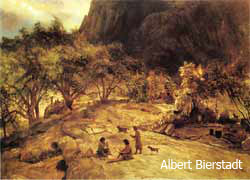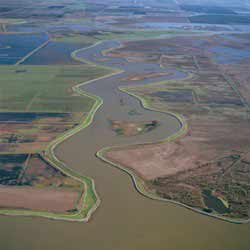History
A Look into Stockton's Past
Before the Gold Rush
 Native Americans lived in the Central Valley for thousands of years before the town of Stockton was built. When Europeans arrived, they found the Yatchicumne, a group of Northern Valley Yokuts people, living in the Stockton area. The Yokuts built their villages on low mounds to keep their homes above floods. A Yokuts village called Pasasimas was located on a mound between Edison and Harrison Streets on what is now the Stockton Channel in downtown Stockton.
Native Americans lived in the Central Valley for thousands of years before the town of Stockton was built. When Europeans arrived, they found the Yatchicumne, a group of Northern Valley Yokuts people, living in the Stockton area. The Yokuts built their villages on low mounds to keep their homes above floods. A Yokuts village called Pasasimas was located on a mound between Edison and Harrison Streets on what is now the Stockton Channel in downtown Stockton.
The Europeans' arrival in Northern California forced many Native Americans into missions or exposed them to new deadly diseases. However, many Native American people still live in San Joaquin County today.
Gold Discovery and Early Development
The discovery of gold on the American River, east of Sacramento, on January 24, 1848, caused Stockton to transform from a small settlement to a thriving commercial center, supplying miners heading up to the Sierra foothills. Stockton got its start when Captain Charles M. Weber, a German immigrant, decided to try his hand at gold mining in late 1848 but soon discovered serving the needs of gold-seekers was a more profitable opportunity. He then founded Stockton in 1849 when he purchased over 49,000 acres of land through a Spanish land grant.
The area now known as Weber Point is the same spot where Captain Weber built the first permanent residence in the San Joaquin Valley. Stockton has boasted several names over the years, including Tuleburg and Mudville, but Captain Weber decided on Stockton in honor of Commodore Robert F. Stockton. Stockton was the first community in California to have an English name; every other community up to that point had been Spanish or Native American in origin.
The City was officially incorporated on July 23, 1850, by the County Court, and the first City election was held on July 31, 1850. In 1851, the City of Stockton received its charter from the State of California. Early settlers included gold seekers from Asia, Africa, Australia, Europe, the Pacific Islands, Mexico, and Canada. Prior to the shift to agriculture as the main industry in Stockton, shipbuilding held sway after the Gold Rush until after World War II.
The Present
Stockton's location at the head of a navigable channel, approximately 90 miles inland from San Francisco Bay, allows the city to continue to serve as a major shipping point for many of the agricultural and manufactured products of Northern California.
Rich peat soil and a temperate climate make the area around Stockton one of the richest agricultural and dairy regions in California. Throughout the 150 years of Stockton's history, almost every major fruit, nut, and field crop has been grown, some with greater success than others. Current major crops include asparagus, cherries, tomatoes, walnuts, and almonds, plus other smaller-production orchard, row and feed crops. Grapes amount to 40 percent of the fruit and nut harvest and contribute 18 percent to the county's agricultural dollar. Prize-winning wines are produced from vineyards north of Stockton, contributing to the international reputation of fine quality California wines.
 The legendary Delta created by the confluence of several rivers and man-made channels, includes 1,000 miles of waterways and defines Stockton's geography. Wildlife, irrigation, transportation, and recreation all owe their success to the muddy waters of the San Joaquin Delta. Stockton and environs have long been known in the entertainment industry as location-rich.
The legendary Delta created by the confluence of several rivers and man-made channels, includes 1,000 miles of waterways and defines Stockton's geography. Wildlife, irrigation, transportation, and recreation all owe their success to the muddy waters of the San Joaquin Delta. Stockton and environs have long been known in the entertainment industry as location-rich.
Stockton has been culturally and ethnically diverse since its beginning as a muddy-street gold-rush camp. Today's diversity is reflected in Stockton street names, many ethnic festivals, architecture, and the faces and heritage of its citizens.
External Links
There are currently no external links.
This City of Stockton web page last reviewed on --- 1/28/2016
